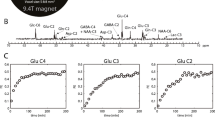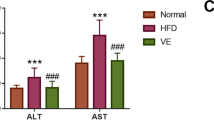Abstract
Hepatic encephalopathy (HE) is a severe neuropsychiatric complication due to acute or chronic liver failure. In this work, an acute thioacetamide induced HE mice model was established to investigate the metabolic events in the onset of HE (OHE) and the protective role of taurine (TAU). Sera for biochemical evaluation, and livers and cortexes for histopathological inspection and NMR-based metabolomic investigation were collected. Principal component analysis and orthogonal partial least squares-discriminant analysis were performed to excavate differential metabolites of OHE, and explore the protective role of TAU. Metabolites pathway analysis was performed on significant metabolites selected based on loading/S-plots and fold change plots to identify biologically meaningful metabolic patterns and relevant pathways. The most affected pathways in OHE mice were those along the liver–brain axis: among them, the alanine, aspartate and glutamate metabolism was the most important. TAU showed better performance in improving the disturbed metabolism in the cortex than in the liver of OHE mice. This pilot study based on metabolomics approach and pathway analysis should help to understand HE systematically, and to develop new therapy for HE.




Similar content being viewed by others
References
Ahboucha, S., & Butterworth, R. F. (2004). Pathophysiology of hepatic encephalopathy: A new look at GABA from the molecular standpoint. Metabolic Brain Disease, 19, 331–343.
Akira, K., Hichiya, H., Morita, M., Shimizu, A., & Mitome, H. (2013). Metabonomic study on the biochemical response of spontaneously hypertensive rats to chronic taurine supplementation using 1H NMR spectroscopic urinalysis. Journal of Pharmaceutical and Biomedical Analysis, 85, 155–161.
Anderson, P., Mahle, D., Doom, T., Reo, N., DelRaso, N., & Raymer, M. (2011). Dynamic adaptive binning: An improved quantification technique for NMR spectroscopic data. Metabolomics, 7, 179–190.
Asha, K., & Devadasan, K. (2013). Protective effect of taurine on the mitochondria of albino rats induced with fulminant hepatic failure. Biomedicine & Preventive Nutrition, 3, 279–283.
Avraham, Y., Grigoriadis, N., Poutahidis, T., Vorobiev, L., Magen, I., Ilan, Y., et al. (2011). Cannabidiol improves brain and liver function in a fulminant hepatic failure-induced model of hepatic encephalopathy in mice. British Journal of Pharmacology, 162, 1650–1658.
Avraham, Y., Israeli, E., Gabbay, E., Okun, A., Zolotarev, O., Silberman, I., et al. (2006). Endocannabinoids affect neurological and cognitive function in thioacetamide-induced hepatic encephalopathy in mice. Neurobiology of Diseases, 21, 237–245.
Avraham, Y., Zolotarev, O., Grigoriadis, N. C., Pautahidis, T., Magen, I., Vorobiav, L., et al. (2008). Cannabinoids and capsaicin improve liver function following thioacetamide-induced acute injury in mice. The American Journal of Gastroenterology, 103, 3047–3056.
Balkan, J., Dogğru-Abbasoğlul, S., Çevikbas, U., Aykaç-Toker, G., & Uysal, M. (2001). Taurine has a protective effect against thioacetamide-induced liver cirrhosis by decreasing oxidative stress. Human and Experimental Toxicology, 20, 251–254.
Barba, I., Chatauret, N., García-Dorado, D., & Cordoba, J. (2008). A 1H nuclear magnetic resonance-based metabonomic approach for grading hepatic encephalopathy and monitoring the effects of therapeutic hypothermia in rats. Liver International, 28, 1141–1148.
Beckonert, O., Keun, H. C., Ebbels, T. M., Bundy, J., Holmes, E., Lindon, J. C., et al. (2007). Metabolic profiling, metabolomic and metabonomic procedures for NMR spectroscopy of urine, plasma, serum and tissue extracts. Nature Protocols, 2, 2692–2703.
Benjamini, Y., & Hochberg, Y. (1995). Controlling the false discovery rate: A practical and powerful approach to multiple testing. Journal of the Royal Statistical Society Series B, 57, 289–300.
Bergeron, M., Layrargues, G. P., & Butterworth, R. F. (1989). Aromatic and branched-chain amino acids in autopsied brain tissue from cirrhotic patients with hepatic encephalopathy. Metabolic Brain Disease, 4, 169–176.
Blei, A. T., & Córdoba, J. (2001). Hepatic encephalopathy. The American Journal of Gastroenterology, 96, 1968–1976.
Boca, S. M., Sinha, R., Cross, A. J., Moore, S. C., & Sampson, J. N. (2014). Testing multiple biological mediators simultaneously. Bioinformatics, 30, 214–220.
Bruck, R., Oren, R., Shirin, H., Aeed, H., Papa, M., Matas, Z., et al. (1998). Hypothyroidism minimizes liver damage and improves survival in rats with thioacetamide induced fulminant hepatic failure. Hepatology, 27, 1013–1020.
Butterworth, R. F. (1996a). Neuroactive amino acids in hepatic encephalopathy. Metabolic Brain Disease, 11, 165–173.
Butterworth, R. F. (1996b). Taurine in hepatic encephalopathy. Advances in Experimental Medicine and Biology, 403, 601–606.
Butterworth, R. F. (2002). Pathophysiology of hepatic encephalopathy: A new look at ammonia. Metabolic Brain Disease, 17, 221–227.
Butterworth, R. F., Lavoie, J., Giguere, J. F., Layrargues, G. P., & Bergeron, M. (1987). Cerebral GABA-ergic and glutamatergic function in hepatic encephalopathy. Neurochemical Patholology, 6, 131–144.
Cauli, O., Rodrigo, R., Llansola, M., Montoliu, C., Monfort, P., Piedrafita, B., et al. (2009). Glutamatergic and gabaergic neurotransmission and neuronal circuits in hepatic encephalopathy. Metabolic Brain Disease, 24, 69–80.
Cloarec, O., Dumas, M. E., Trygg, J., Craig, A., Barton, R. H., Lindon, J. C., et al. (2005). Evaluation of the orthogonal projection on latent structure model limitations caused by chemical shift variability and improved visualization of biomarker changes in 1H NMR spectroscopic metabonomic studies. Analytical Chemistry, 77, 517–526.
Coen, M., Holmes, E., Lindon, J. C., & Nicholson, J. K. (2008). NMR-based metabolic profiling and metabonomic approaches to problems in molecular toxicology. Chemical Research in Toxicology, 21, 9–27.
Cordoba, J., Gottstein, J., & Blei, A. T. (1998). Chronic hyponatremia exacerbates ammonia-induced brain edema in rats after portacaval anastomosis. Journal of Hepatology, 29, 589–594.
Das, J., Ghosh, J., Manna, P., & Sil, P. C. (2010). Protective role of taurine against arsenic-induced mitochondria-dependent hepatic apoptosis via the inhibition of PKCδ-JNK pathway. PLoS ONE, 5, 12602–12620.
Dieterle, F., Ross, A., Schlotterbeck, G., & Senn, H. (2006). Probabilistic quotient normalization as robust method to account for dilution of complex biological mixtures. Application in 1H NMR metabonomics. Analytical Chemistry, 78, 4281–4290.
Dorğru-Abbasoğlu, S., Kanbağli, Ö., Balkan, J., Çevikbaş, U., Aykaç-Tokerl, G., & Uysall, M. (2001). The protective effect of taurine against thioacetamide hepatotoxicity of rats. Human and Experimental Toxicology, 20, 23–27.
Ferenci, P., Lockwood, A., Mullen, K., Tarter, R., Weissenborn, K., & Blei, A. T. (2002). Hepatic encephalopathy—definition, nomenclature, diagnosis, and quantification: Final report of the working party at the 11th World Congresses of Gastroenterology, Vienna, 1998. Hepatology, 35, 716–721.
Fonville, J. M., Richards, S. E., Barton, R. H., Boulange, C. L., Ebbels, T., Nicholson, J. K., et al. (2010). The evolution of partial least squares models and related chemometric approaches in metabonomics and metabolic phenotyping. Journal of Chemometrics, 24, 636–649.
Hammes, T. O., Pedroso, G. L., Hartmann, C. R., Escobar, T. D. C., Fracasso, L. B., da Rosa, D. P., et al. (2012). The effect of taurine on hepatic steatosis induced by thioacetamide in zebrafish (Danio rerio). Digestive Diseases and Sciences, 57, 675–682.
Hilgier, W., Zielińska, M., Borkowska, H. D., Gadamski, R., Walski, M., Oja, S. S., et al. (1999). Changes in the extracellular profiles of neuroactive amino acids in the rat striatum at the asymptomatic stage of hepatic failure. Journal of Neuroscience Research, 56, 76–84.
Holmes, E., Cloarec, O., & Nicholson, J. (2006). Probing latent biomarker signatures and in vivo pathway activity in experimental disease states via statistical total correlation spectroscopy (STOCSY) of biofluids: Application to HgCl2 toxicity. Journal of Proteome Research, 5, 1313–1320.
Izquierdo-García, J. L., Rodríguez, I., Kyriazis, A., Villa, P., Barreiro, P., Desco, M., et al. (2009). A novel R-package graphic user interface for the analysis of metabonomic profiles. BMC Bioinformatics, 10, 363.
Jalan, R., Shawcross, D., & Davies, N. (2003). The molecular pathogenesis of hepatic encephalopathy. The International Journal of Biochemistry & Cell Biology, 35, 1175–1181.
Jiménez, B., Montoliu, C., MacIntyre, D. A., Serra, M. A., Wassel, A., Jover, M., et al. (2010). Serum metabolic signature of minimal hepatic encephalopathy by 1H nuclear magnetic resonance. Journal of Proteome Research, 9, 5180–5187.
Junyent, F., Utrera, J., Romero, R., Pallas, M., Camins, A., Duque, D., et al. (2009). Prevention of epilepsy by taurine treatments in mice experimental model. Journal of Neuroscience Research, 87, 1500–1508.
Larsson, S. (1957). Food preferences in obesity caused by goldthioglucose. Acta Physiologica Scandinavica, 40, 367–376.
Lindon, J. C., Holmes, E., Bollard, M. E., Stanley, E. G., & Nicholson, J. K. (2004). Metabonomics technologies and their applications in physiological monitoring, drug safety assessment and disease diagnosis. Biomarkers, 9, 1–31.
McPhail, M. J., & Taylor-Robinson, S. D. (2010). The role of magnetic resonance imaging and spectroscopy in hepatic encephalopathy. Metabolic Brain Disease, 25, 65–72.
Miyazaki, T., & Matsuzaki, Y. (2014). Taurine and liver diseases: A focus on the heterogeneous protective properties of taurine. Amino Acids, 46, 101–110.
Nicholson, J., Lindon, J., & Holmes, E. (1999). Metabonomics: Understanding the metabolic responses of living systems to pathophysiological stimuli via multivariate statistical analysis of biological NMR spectroscopic data. Xenobiotica, 29, 1181–1189.
Norskov, N. P., Hedemann, M. S., Laerke, H. N., & Knudsen, K. E. B. (2013). Multicompartmental nontargeted LC–MS metabolomics: Explorative study on the metabolic responses of rye fiber versus refined wheat fiber intake in plasma and urine of hypercholesterolemic pigs. Journal of Proteome Research, 12, 2818–2832. doi:10.1021/pr400164b.
Oja, S. S., & Saransaari, P. (2007). Pharmacology of taurine. In: Proceedings-Western Pharmacology Society, (vol 50). Western Pharmacology Society, 1998, pp. 8–15
Panikashvili, D., Simeonidou, C., Ben-Shabat, S., Hanuš, L., Breuer, A., Mechoulam, R., et al. (2001). An endogenous cannabinoid (2-AG) is neuroprotective after brain injury. Nature, 413, 527–531.
Riordan, S. M., & Williams, R. (1997). Treatment of hepatic encephalopathy. New England Journal of Medicine, 337, 473–479.
Rosemberg, D. B., da Rocha, R. F., Rico, E. P., Zanotto-Filho, A., Dias, R. D., Bogo, M. R., et al. (2010). Taurine prevents enhancement of acetylcholinesterase activity induced by acute ethanol exposure and decreases the level of markers of oxidative stress in zebrafish brain. Neuroscience, 171, 683–692.
Saransaari, P., & Oja, S. S. (2000). Taurine and neural cell damage. Amino Acids, 19, 509–526. doi:10.1007/s007260070003.
Schauer, N., & Fernie, A. R. (2006). Plant metabolomics: Towards biological function and mechanism. Trends in Plant Science, 11, 508–516.
Sergeeva, O. A. (2013). GABAergic transmission in hepatic encephalopathy. Archives of Biochemistry and Biophysics, 536, 122–130.
Suarez, I., Bodega, G., & Fernandez, B. (2002). Glutamine synthetase in brain: Effect of ammonia. Neurochemistry International, 41, 123–142.
Westerhuis, J., Hoefsloot, H. J., Smit, S., Vis, D., Smilde, A., Velzen, E. J., et al. (2008). Assessment of PLSDA cross validation. Metabolomics, 4, 81–89. doi:10.1007/s11306-007-0099-6.
Wishart, D. S., Jewison, T., Guo, A. C., Wilson, M., Knox, C., Liu, Y., et al. (2013). HMDB 3.0—The Human Metabolome Database in 2013. Nucleic Acids Research, 41, D801–D807. doi:10.1093/nar/gks1065.
Wishart, D. S., Knox, C., Guo, A. C., Eisner, R., Young, N., Gautam, B., et al. (2009). HMDB: A knowledgebase for the human metabolome. Nucleic Acids Research, 37, D603–D610.
Wishart, D. S., Tzur, D., Knox, C., Eisner, R., Guo, A. C., Young, N., et al. (2007). HMDB: The human metabolome database. Nucleic Acids Research, 35, D521–D526.
Xia, J., Mandal, R., Sinelnikov, I. V., Broadhurst, D., & Wishart, D. S. (2012). MetaboAnalyst 2.0—a comprehensive server for metabolomic data analysis. Nucleic Acids Research, 40, W127–W133.
Xia, J., Psychogios, N., Young, N., & Wishart, D. S. (2009). MetaboAnalyst: A web server for metabolomic data analysis and interpretation. Nucleic Acids Research, 37, W652–W660.
Xia, J., & Wishart, D. S. (2010). MetPA: A web-based metabolomics tool for pathway analysis and visualization. Bioinformatics, 26, 2342–2344.
Zeng, K., Xu, H., Chen, K., Zhu, J., Zhou, Y., Zhang, Q., et al. (2010). Effects of taurine on glutamate uptake and degradation in Müller cells under diabetic conditions via antioxidant mechanism. Molecular and Cellular Neuroscience, 45, 192–199.
Acknowledgments
This work was funded by National Natural Science Foundation of China (NSFC) Grant 81173526, the Program for New Century Excellent Talents in University (NCET-11-0738), the Fundamental Research Funds for the Central Universities (No. 30920130112014) and the Program for Changjiang Scholars and Innovative Research Team in University (PCSIRT-IRT1193).
Conflict of interest
All the authors declare that there are no conflicts of interest.
Author information
Authors and Affiliations
Corresponding authors
Electronic supplementary material
Below is the link to the electronic supplementary material.
Rights and permissions
About this article
Cite this article
Wei, DD., Wang, JS., Li, MH. et al. A pilot study of the onset of hepatic encephalopathy (OHE) in mice induced by thioacetamide and the protective effect of taurine by holistic metabolic characterization. Metabolomics 11, 559–570 (2015). https://doi.org/10.1007/s11306-014-0715-1
Received:
Accepted:
Published:
Issue Date:
DOI: https://doi.org/10.1007/s11306-014-0715-1




